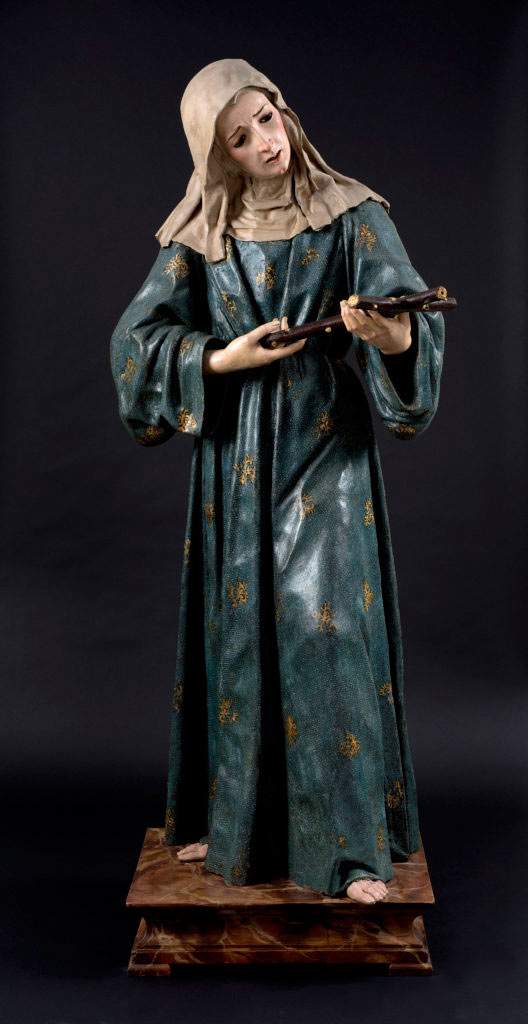Very bizarre is what is happening in Spain, in Granada, Andalusia’s fourth-largest city: the police are in fact investigating the nuns of the local convent of Nuestra Señora de los Ángeles after a sculpture identical to the one that once stood on the altar of the Poor Clares’ church ended up, nobody knows how, on the market. The work, a St. Margarita of Cortona made by Baroque sculptor José de Mora (Baza, 1642 - Granada, 1724), was in fact in the catalog of the TEFAF fair in New York (one of the world’s leading antiques fairs), with a list price of 350 thousand euros, offered by gallery owner Nicolás Cortés of Madrid.
Investigators believe that the statue was sold illegally after the convent was closed in 2018, and in Spain selling ecclesiastical property without involving the state is illegal: Article 28.1 of Law 16 of June 25, 1985, the “Ley del Patrimonio Histórico Español,” in fact prohibits the sale of ecclesiastical property (it is only possible to sell it to the state). Experts who have examined the work believe it is highly probable that the Mora statue is the one until not long ago on the altar of the Poor Clares’ church, but the sisters deny all allegations. Mother Josefa, who is in charge of coordinating the convents of the Spanish Poor Clares, sent a statement to the daily El País in which she affirmed that “the convent of Nuestra Señora de los Ángeles did not have any image” depicting St. Margaret of Cortona, and in which she explained that the convent is still in possession of a statue (but without specifying where it is currently located), similar to the one put up for sale by Cortés, which would, however, depict a Saint Rose of Viterbo, executed by an unknown author.
El País refuted the nun’s version by first stating that, in 1953, art historian Antonio Gallego y Burín, an expert on José de Mora, published the sculpture as a work by Mora in his Granada. Guía artística e histórica de la ciudad, and then that the heritage conservator of the regional junta of Andalusia, José Luis Romero Torres (who also signed the attribution card for Cortés), confirmed that in fact the statue in the convent and the one for sale by TEFAF are the same sculpture. Romero Torres added that convent holdings are not inventoried and that “unfortunately the sale is a regular practice, which is occurring all over Spain.” Also agreeing with Romero Torres’ version is Lázaro Gila, professor of art history at the University of Granada, who has no doubt that the work that went up for sale is the one from the convent. “José de Mora never made the same image twice,” Gila says.
Cortés assures that he bought the Saint Margarita from an antiquarian (“I would never have bought it from a convent, I know it’s illegal, what I didn’t know is that the nuns were selling their works,” he told El País), for the sum of one hundred thousand euros, in 2017, a few months before the convent closed. At the moment, the gallerist is cooperating with the authorities, and has provided the invoice for the purchase and the export permits received from the Spanish Ministry of Culture, according to which the documentation provided by Cortés confirmed that the work was purchased from a private individual in Zaragoza and not from an ecclesiastical institution. The ministry communicated everything to the police so as to conduct the most thorough investigation into the provenance of the work (in the sales catalogs the provenance was not specified). It will therefore be a matter of understanding what were all the steps through which the sculpture ended up on the market.
Moreover, this is not the first time that the same convent is suspected of selling works of art. In 2018, other objects once in its possession (a processional altarpiece and some sculptures) were found in a stall at El Rastro, Madrid’s most famous flea market. At the time, the sisters defended themselves by saying that the works had been sent to Madrid to be restored, but since there was no agreement between the parties, they would recover them and bring them back to Granada (and the investigation closed).
Pictured: the finished Saint Margaret of Cortona by José de Mora for sale (polychrome wood, 158 x 62 x 59 cm).
 |
| Spain, police investigate nuns at a Granada convent: one of their works, no one knows how, ended up on the market |
Warning: the translation into English of the original Italian article was created using automatic tools. We undertake to review all articles, but we do not guarantee the total absence of inaccuracies in the translation due to the program. You can find the original by clicking on the ITA button. If you find any mistake,please contact us.